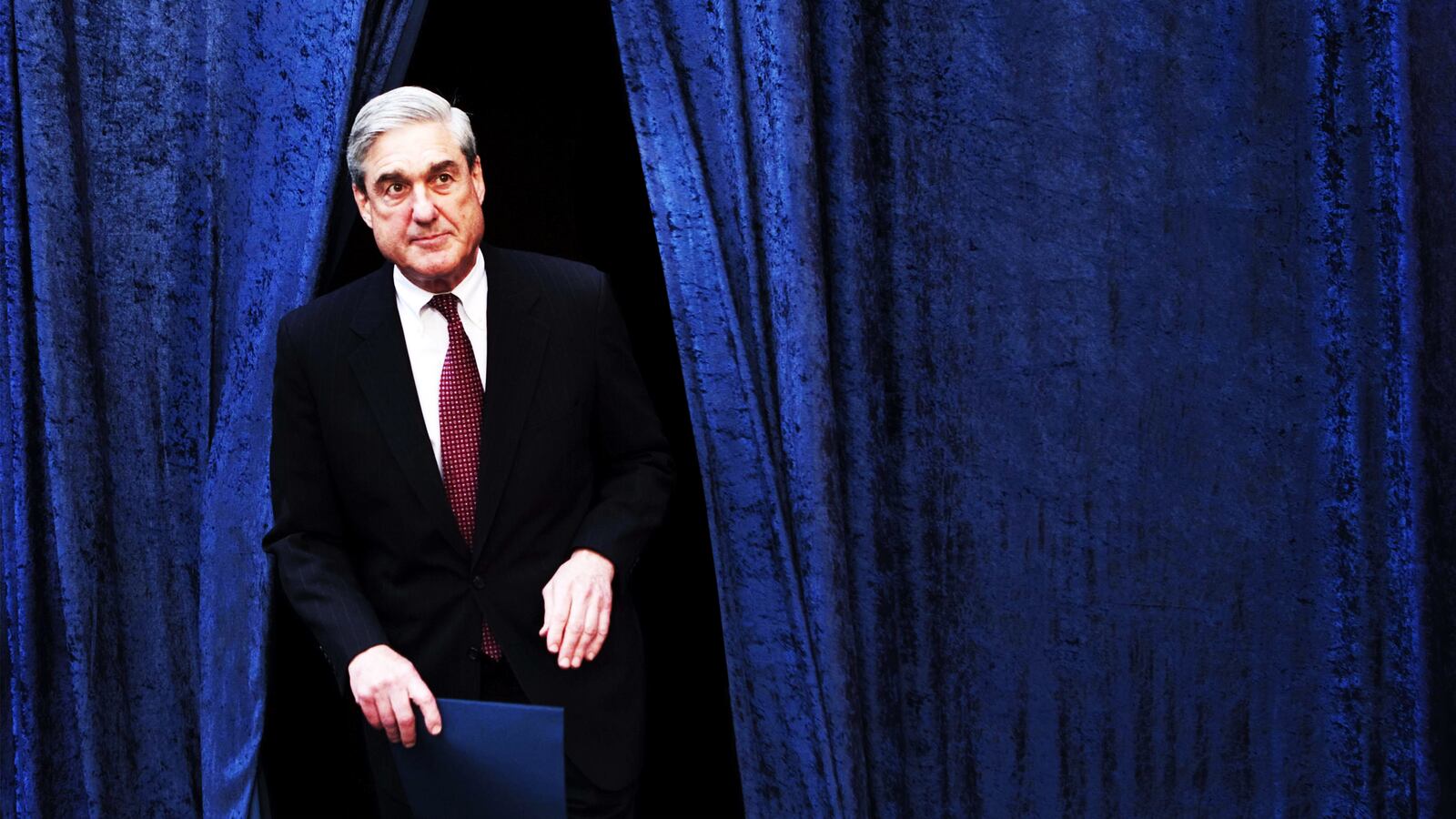Special Counsel Robert Mueller found that President Trump tried to control the investigation of Russian interference in the 2016 election and encouraged witnesses not to cooperate—but Attorney General William Barr decided that didn’t amount to a crime.
At a press conference ahead of the Mueller report’s release, Barr went out of his way to explain how he disagreed with some of Mueller’s legal theories and excuse Trump’s behavior. Barr proclaimed Trump’s innocence and justified the president’s actions as the understandable behavior of a man believing he is persecuted by political opponents.
But when the redacted report was finally released to the public, it outlined 10 episodes of possible obstruction of justice by Trump, including: ordering James Comey to drop the FBI investigation into national security advisor Michael Flynn; directing the White House counsel to fire Mueller; dictating a message to Attorney General Jeff Sessions to limit the Mueller probe; telling witnesses publicly not to cooperate; having Cohen not contradict him in congressional testimony about Trump Tower Moscow; trying to hide emails exposing Donald Trump Jr.’s meeting with Russians for “dirt” on Hillary Clinton.
After Trump fired Comey in May 2017, his behavior entered a dangerous new stage.
“At that point, the president engaged in a second phase of conduct involving public attacks on the investigation, non-public efforts to control it, and efforts in both private and public to encourage witnesses not cooperate with the investigation,” according to the report.
Mueller did not make a judgement on whether Trump committed an offense, but the report said it does not exonerate him either.
The report also reveals new details about the Trump campaign’s proximity to Moscow’s election plot, though it didn’t amount to collusion.
“In sum, the investigation established multiple links between Trump Campaign officials and individuals tied to the Russian government,” the report stated. “Those links included Russian offers of assistance to the Campaign. In some instances, the Campaign was receptive to the offer, while in other instances the Campaign officials shied away. Ultimately, the investigation did not establish that the Campaign coordinated or conspired with the Russian government in its election-interference activities.”
The report unveils a 2016 meeting between Trump’s campaign chairman and a former Russian intelligence officer, Konstantin Kilimnik.
Manafort started sharing polling data with Kilimnik that August and continued for some time after. “They also discussed the status of the Trump Campaign and Manafort’s strategy for winning Democratic votes in Midwestern states,” according to the report.

Deputy Attorney General Rod Rosenstein listens while Attorney General William Barr speaks during a press conference about the release of the Mueller Report at the Department of Justice.
Brendan Smialowski / GettyThe report suggests Trump had advanced knowledge about the planned dumps of Democratic emails hacked by Russia and given to WikiLeaks.
After the first dump in July 2016, Trump called Manafort and his deputy Rick Gates to tell them “more releases of damaging information would be coming,” in the report’s words. Cohen told investigators that during a meeting around the same time, Trump said something to Cohen—but the words are redacted because they could “harm an ongoing matter.”
Trump also “repeatedly” asked Flynn during the campaign to find Hillary Clinton's mythic 30,000 missing emails (after Trump already publicly called on Russia to find them). The effort did not ultimately recover emails and was not part of a coordinated effort between Russia and the campaign, according to the report.
Meanwhile, individuals associated with Russia presented two plans to help Russia. Kilimnik gave Manafort a “peace plan” to end Russia’s war in Ukraine that Manafort called a “backdoor” to Moscow control of eastern Ukraine. In another instance, the chief executive of Russia’s sovereign wealth fund steered a “reconciliation” plan to Trump’s son-in-law, Jared Kushner, that was circulated inside the Trump administration.
Barr spoke before even releasing the report, spinning the findings as favorable for Trump.
The attorney general said he and Deputy Attorney General Rod Rosenstein concluded that the evidence gathered by Mueller “is not sufficient to establish” that Trump committed an obstruction-of-justice offense.
Barr then went on to exonerate Trump’s behavior as understandable.
“And as the special counsel’s report acknowledges, there is substantial evidence to show that the president was frustrated and angered by a sincere belief that the investigation was undermining his presidency, propelled by his political opponents, and fueled by illegal leaks,” Barr said.
Trump immediately tweeted a gloating image of himself after Barr finished speaking. “No collusion, no obstruction. For the haters and the radical left Democrats,” it read in Game of Thrones script. “GAME OVER.”
Trump said at a White House event shortly after, “This should never happen to another president again, this hoax.”
The president and the attorney’s words were in sharp contrast to those of Mueller himself.
“While this report does not conclude the president committed a crime, it also does not exonerate him,” his report stated.
Over the past four weeks, Barr has worked to redact portions of Mueller’s report that contained grand jury information, classified intelligence, and what he said were allegations that could disparage people who were not charged with crimes.
The 400-plus-page report will be handed over to Congress where Democrats have said they are prepared to sue the Justice Department to see Mueller’s findings in their entirety.
Mueller’s office indicted 34 people—more than any other special counsel in history—including high-level figures in Trump’s world: Cohen, Flynn, Manafort, Gates, and long-time political advisor Roger Stone.
The special counsel’s investigation started in dramatic fashion: Mueller was appointed by Rosenstein after Trump fired Comey in May 2017. The appointment led Trump to privately declare “I’m fucked,” according to the report. Trump then sought to have Mueller fired or his investigation limited, the special counsel found.
Mueller, a laconic 74-year-old former director of the FBI, has not said a word publicly in almost two years, creating a ravenous appetite to learn what would be in his report.
But even before the report’s release, the story of Mueller’s work was hidden in plain sight: a global conspiracy centered in the Kremlin to elect Trump as president.
In an unprecedented attack on political infrastructure of the United States, military officers in Russia hacked into Democrats’ computers, stole emails, and release them to embarrass Clinton. The plot was first hatched years earlier, according to Mueller’s team, when Russians began studying how to manipulate Americans and turn them against each other, with one key lesson being to exploit the country’s racism. Working from a “troll farm” in St. Petersburg, Russians spread anti-Clinton fake news and pro-Trump propaganda across Facebook, Twitter, YouTube, and Instagram—all the while Silicon Valley slept.
At the same time, Russians approached the Trump campaign with promises of “dirt” on Clinton in the form of emails and offers for Trump to meet Russian President Vladimir Putin. (In both cases, the offers apparently went unrealized.) Mueller’s investigation also revealed Russia offered to help Trump build a skyscraper in Moscow while he ran for president—contrary to his repeated statements he had “no business in Russia”—with Trump’s former attorney Cohen calling the Kremlin for assistance.
Though the Trump campaign was not accused by Mueller of colluding with Russia, the investigation revealed it spoke to two figures adjacent to Moscow’s scheme. Manafort’s meeting with Kilimnik is said to go to the “heart” of the investigation, Mueller’s team said in a court hearing that remains partially redacted. Stone’s full interactions with WikiLeaks remain obscured by redactions ahead of his upcoming trial on charges he lied to Congress about his actions.
Finally, Mueller’s investigation exposed Washington corruption that was seen as just another way of doing business: unregistered foreign lobbying. Manafort and Gates were charged with illegally lobbying D.C. on behalf of Ukrainian political interests. Democratic power players Tony Podesta and Greg Craig were also investigated for the same violations, with Craig being indicted this month after Mueller’s investigation finished.
While Mueller’s investigation is over, his work lives on across the Justice Department with 14 referrals made to other prosecutors, according to the report—12 of them hidden. At least one that is known is the Cohen case that Mueller gave to federal prosecutors in Manhattan who reportedly continue to investigate the president’s business and inaugural committee.
— With additional reporting by Erin Banco, Jackie Kucinich, Adam Rawnsley, Gideon Resnick, Kevin Poulsen, Harry Siegel, Sam Stein.







